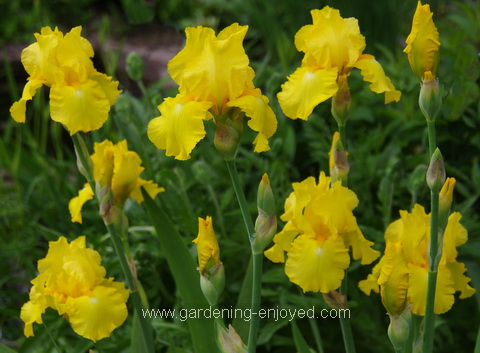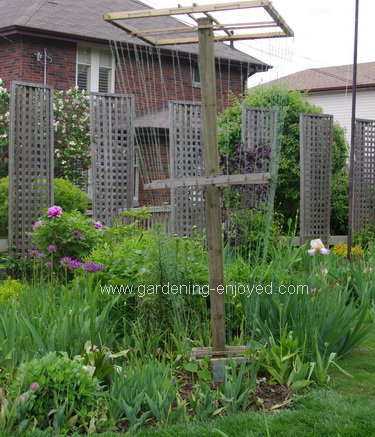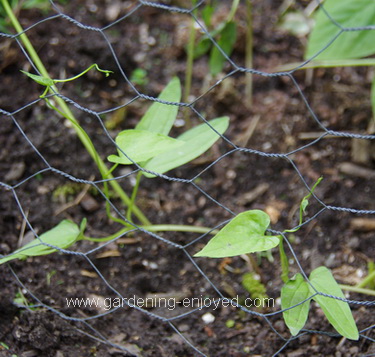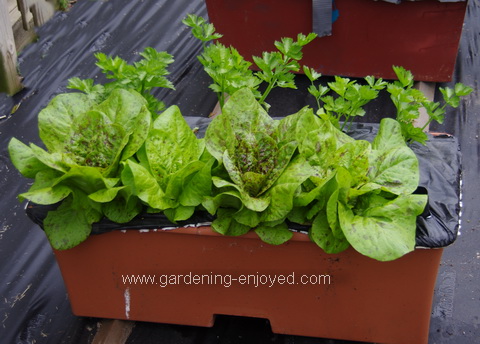
To refer to our weather as regular rain would be a huge understatement. There is, however, usually an upside to any situation. Apparently cool damp, actually wet, weather is wonderful for my favourite perennial, Iris. I wander the garden daily amazed at the number of bloom stalks on each and every Iris clump. There will be at least three weeks of amazing blooms and a nice touch of fragrance with them. The task now is to carry blooms around the garden trying to figure out if I have duplicates. I am running out of room for new varieties and that means rooting out those duplicates to create space. I have found three so far and I expect more to show up as later varieties bloom. There are several other clumps that are too big and are developing big gaps and I need to mark those to be dug and divided. The push to do that now is so that I can mark those clumps and take pictures. People are even more eager to accept new
Iris when I can show them a picture of what they are receiving. The fact that I haven’t been able to finish all the spring planting leaves me with less time to organize the Iris but I do make sure I have to time to wander and admire them.
 This large string trellis is one of my best Vertical Vegetable devices. In mid summer it is covered with Pole Beans and Morning Glories, the Heavenly Blue variety that is one of my favourite annual flowers. It is such a true blue colour. Mother Nature has made this structure somewhat of a greater challenge the last few years. I used to just plant it with little Morning Glory plants and either seeds or plants of the various varieties of Pole Beans that I have grown. Slugs have discovered these little plants and now I spread some slug bait around the newly planted vines. That problem seems solved and now the bunnies have moved in. Interestingly they love to chew down the bean plants but seem to leave the Morning Glories alone. A little temporary fencing is called for to keep the
rapacious rabbits at bay. Once the plants are established and growing well the rabbits move on to other delicacies and I can remove the rather ugly bits of fencing.
This large string trellis is one of my best Vertical Vegetable devices. In mid summer it is covered with Pole Beans and Morning Glories, the Heavenly Blue variety that is one of my favourite annual flowers. It is such a true blue colour. Mother Nature has made this structure somewhat of a greater challenge the last few years. I used to just plant it with little Morning Glory plants and either seeds or plants of the various varieties of Pole Beans that I have grown. Slugs have discovered these little plants and now I spread some slug bait around the newly planted vines. That problem seems solved and now the bunnies have moved in. Interestingly they love to chew down the bean plants but seem to leave the Morning Glories alone. A little temporary fencing is called for to keep the
rapacious rabbits at bay. Once the plants are established and growing well the rabbits move on to other delicacies and I can remove the rather ugly bits of fencing.

I have two of these structures and moved one of them to this location in the middle of the front perennial bed this year. Didn’t fence it right away as I thought maybe the bunnies wouldn’t find it. Wrong! It is now fenced and a few new bean seeds planted beside some of the chewed specimens. Thinking that I had successfully solved Mother Nature’s challenges I started to relax. One of the early jobs on these structures is to make sure that the two types of vines find their way onto the string. While checking that I found this. The Morning Glories were starting to wind themselves around the fencing instead of the string. Just another little adjustment, unwinding those vines from the fence and introducing them to the string. That’s what I “love” about gardening, always another challenge to overcome.

After the challenges, comes the unexpected rewards. My expanding vegetable garden that is growing in sub-irrigation containers such as the commercial Earthbox is regularly providing new benefits. I have been able to plant them despite the continuous rain. Much of the vegetable garden is too wet to work in but that doesn’t affect the planting of those containers. They are growing amazing crops and the Lettuce in this picture is the second crop to find a home in that container. Some early Pak Choi has already graced our dinner plates. The Lettuce seedlings were growing in the cold frame and replaced the Pak Choi the day it was harvested. Now the Lettuce is ready to become a tasty part of my dinner salad. As that lettuce finds its way to the kitchen, their spaces will be filled with Peppers. Other containers have large Chinese or Napa Cabbage almost ready to eat and the beets and carrots are well up and looking to be thinned. That’s a job I can do even when the soil is too wet to work in. I’ve just planted three of the new boxes with Tomatoes and they are all standing up and looking good. Adding new ideas to successful old ones should make an even better idea. The boxes with the Tomatoes in them are organized so that those vines can still use my Tomato Structure to increase the Tomato harvest in small spaces by growing them vertically. Stay tuned for more news on this as they grow through the season.
Now it’s time to answer a few of my reader’s questions. To ask
a question just “reply” to this ezine. Don’t forget to check the front page of the Website for frequent short ideas for current gardening activities.
Bill Asks? Flowers by the million are right there in front of us at this time of year". Before I realized that you were talking about tree flowers, I thought the topic was dandelions. They seem now to be the National Flower, at least in my area. Recently I have seen several mentions of the importance of dandelions as a spring food source for bees. Based on how many times I notice bees around dandelions ( that is, never), I suspect this is just an urban myth perpetuated by people who are too lazy to deal with dandelions, or who actually like them.
Maybe I am just very unobservant. Please can you throw any light on the matter?
Ken Answers! Well now, here’s a discussion with several sides to it. Dandelions do, in fact,
supply a good deal of nectar for bees and other pollinators. On the other hand, if they are getting all of their nectar from the Dandelions then they aren’t pollinating other plants. I happen to like Dandelions but I still dig them out of most of my yard because they are competitors for space, water and nutrients for my other plants. The park behind me is a few hectares of Dandelions that puts on a wonderful show of brilliant yellow that I enjoy and I don’t think the few I dig out are going to matter to the bees and the desired plants in their place will help the bees have a diversified diet.
Betty Anne Asks? Two or three years ago my impatients fell victim to that disease which travelled through the area. My question is that disease left in the soil or is it safe to try them again in that same flowerbed?
Ken Answers! The spores from Impatiens downy mildew will stay viable on the soil for two years. I see garden centres selling a
few more impatiens but I’m not ready to try them again just yet.
John Asks? We have a viburnum which right now has wonderful white puffs of flower. I've noticed some colonies of tiny black bugs on the stems at the top of the bush that currently stands about 8 ft tall. I've tried spraying with Bordo mixture but to no success. I've manually reached up and cut off the branches that have the colonies of the 'bugs". In the past we've lost the bush leaves and all but last year was fine but I fear this year we're threatened. I spray dormant spray each spring - perhaps I was too late this year. What is this bug and how do I get rid of it.
Ken Answers! I suspect that you have aphids on your viburnum. Bordo is a great fungicide for Tomato blight but will probably only annoy the aphids. Insecticidal soap should work but you will have to spray it a few times a couple of days apart to kill each emerging generation. A strong blast of water
from your hose will physically knock them off the plant and you can keep doing that as you see the population start to return.

 This large string trellis is one of my best Vertical Vegetable devices. In mid summer it is covered with Pole Beans and Morning Glories, the Heavenly Blue variety that is one of my favourite annual flowers. It is such a true blue colour. Mother Nature has made this structure somewhat of a greater challenge the last few years. I used to just plant it with little Morning Glory plants and either seeds or plants of the various varieties of Pole Beans that I have grown. Slugs have discovered these little plants and now I spread some slug bait around the newly planted vines. That problem seems solved and now the bunnies have moved in. Interestingly they love to chew down the bean plants but seem to leave the Morning Glories alone. A little temporary fencing is called for to keep the
rapacious rabbits at bay. Once the plants are established and growing well the rabbits move on to other delicacies and I can remove the rather ugly bits of fencing.
This large string trellis is one of my best Vertical Vegetable devices. In mid summer it is covered with Pole Beans and Morning Glories, the Heavenly Blue variety that is one of my favourite annual flowers. It is such a true blue colour. Mother Nature has made this structure somewhat of a greater challenge the last few years. I used to just plant it with little Morning Glory plants and either seeds or plants of the various varieties of Pole Beans that I have grown. Slugs have discovered these little plants and now I spread some slug bait around the newly planted vines. That problem seems solved and now the bunnies have moved in. Interestingly they love to chew down the bean plants but seem to leave the Morning Glories alone. A little temporary fencing is called for to keep the
rapacious rabbits at bay. Once the plants are established and growing well the rabbits move on to other delicacies and I can remove the rather ugly bits of fencing.


